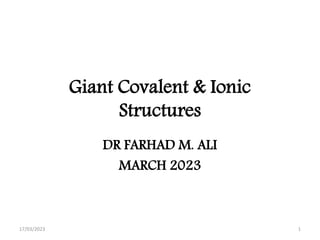
Giant Covalent and Ionic Structures
- 1. Giant Covalent & Ionic Structures DR FARHAD M. ALI MARCH 2023 17/03/2023 1
- 2. Giant structures Either covalent or ionic Covalent: carbon (diamond, graphite); silicon dioxide; polymer (made from non- metals which form giant structures) Ionic: giant metallic lattice: sodium and aluminium as examples giant ionic lattice: ionic compounds such sodium chloride. 17/03/2023 2
- 3. What are giant covalent structures? • When a large number of atoms are joined by covalent bonds, it creates a giant covalent structure. • A giant covalent structure has lots of covalent bonds linking several atoms in a regular pattern, which forms a lattice. 17/03/2023 3
- 4. Carbon atoms in diamond form a tetrahedral arrangement. Each Carbon atom bonded to four others. 17/03/2023 4
- 5. Diamond-it is pure carbon- It is an allotrope of carbon • All the properties of diamond is because of the fact that the strong covalent bonds extended in all directions through the whole structure of the crystal 17/03/2023 5
- 6. 17/03/2023 6
- 7. Graphite-it is pure carbon It is an allotrope of carbon 17/03/2023 7
- 8. Graphite-it is pure carbon It is an allotrope of carbon 17/03/2023 8
- 9. Graphite-it is pure carbon It is an allotrope of carbon • Graphite is brittle as little energy is required to break the weak induce dipole forces but, • it still has a very high melting point as a lot of energy is needed to break the large number of covalent bonds. • Graphite has a low density because the distance between the layers is large. As the layers in graphite are held together by weak intermolecular forces, the layers are far apart. 17/03/2023 9
- 10. Graphene-it is pure carbon Also an allotrope of carbon 17/03/2023 10
- 11. Graphene-it is pure carbon Also an allotrope of carbon Graphene is technically composed of carbon atom and a covalent bond that formed a honeycomb pattern. is made of a single sheet of carbon atoms arranged in a crystal lattice (like a honeycomb pattern). It is the basic building block of graphite. show high melting points than many other materials 17/03/2023 11
- 12. Silicon dioxide SiO2 (also known as silica) This is the structure of SiO2. This has a giant structure This is just a tiny part of a giant structure extending on all 3 dimensions. 17/03/2023 12
- 13. Silicon dioxide SiO2 • When we look at the structure we see that the silicon bonds to 4 oxygen atoms but why do we say SiO2? • The Silicon atom is bonded to 4 Oxygen atoms and each Oxygen is bonded to 2 other silicon atoms. This leads to a ratio of 1:2 17/03/2023 13
- 14. The physical properties of silicon dioxide • has a high melting point (around 1700°C). • Very strong silicon-oxygen covalent bonds have to be broken throughout the structure before melting occurs. • is hard. This is due to the need to break the very strong covalent bonds. • doesn't conduct electricity. There aren't any delocalised electrons. All the electrons are held tightly between the atoms, and aren't free to move. • is insoluble in water and organic solvents. 17/03/2023 14
- 15. Why do giant covalent structures have high melting points? • These structures have high melting points due to the covalent bonds holding the atoms together. • It is very difficult to break down these bonds when they are melted and they require a large amount of energy (i.e. a high temperature) to break the structure. 17/03/2023 15
- 16. Are giant covalent structures soluble in water? • These structures are insoluble due to their strong covalent bonds. • Therefore, these are generally inert and so do not react with water, making it impossible to dissolve 17/03/2023 16
- 17. Why do giant covalent structures not conduct electricity? • The structures are poor electrical conductors of electricity because they do not have free electrons to conduct electricity through the molecule. • However, graphite is an exception. 17/03/2023 17
- 18. Metallic Bonding- • Metallic bonding is a type of chemical bonding that arises from the electrostatic attractive force between conduction electrons (in the form of an electron cloud of delocalized electrons) and positively charged metal ions 17/03/2023 18
- 20. 17/03/2023 20
- 21. Metallic Bonding- • Most metals have high melting and boiling points- • Since the attraction forces between the delocalised and positive metal ions-this need high energy to overcome this attraction. • Metals are good conductors for heat and electricity- • Since the mobile electrons can move throgh the structure, carrying electricity. • They are malleable: easily bent and shaped • ductile: streched into wires • Atoms of metal arranged in layers-when a forc is applied, the layers can slid over each other-forming new bonds this will leave the metal with a different shape. 17/03/2023 21
- 22. 17/03/2023 22
- 23. 17/03/2023 23
- 24. 17/03/2023 24
- 25. 17/03/2023 25